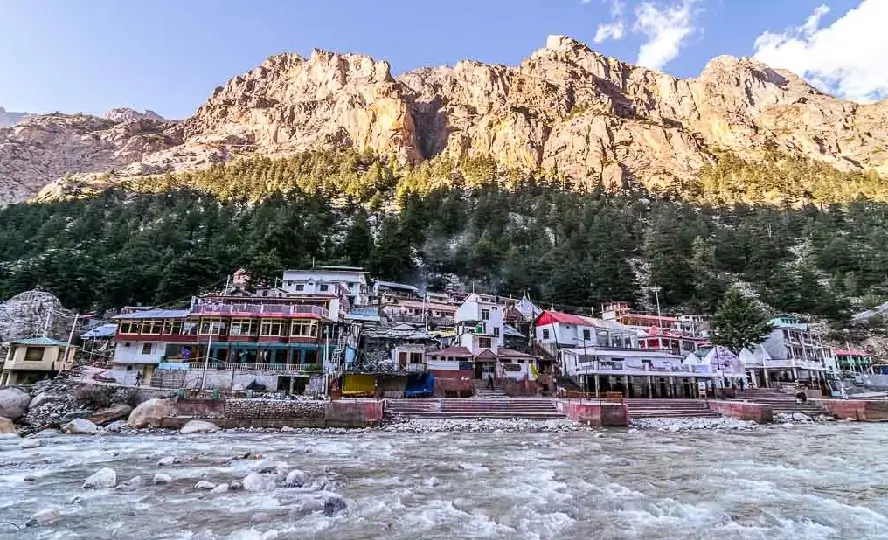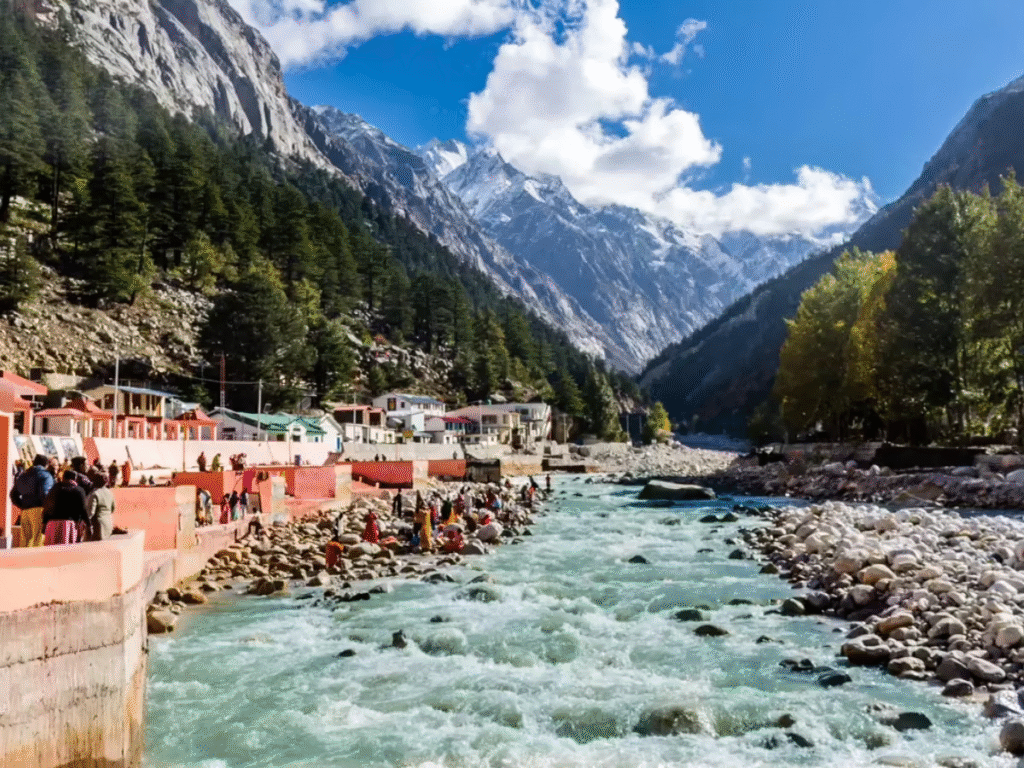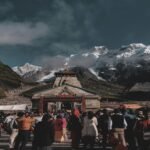
The Divine Origin of Maa Ganga
For billions of people, she’s not just H₂O; she’s Maa Ganga—a mother, a lifeline, and a thread connecting us to India’s oldest traditions. The feeling you get when you stand by her banks is simply unmatched.
The pilgrimage we’re covering today, the Gangotri Temple Yatra, takes you right to the most sacred spot: her origin. Tucked high up in the quiet, breathtaking Garhwal Himalayas of Uttarakhand, Gangotri is one of the four essential stops on the famous Char Dham Yatra.
This journey is intense, mixing real physical challenge with immense spiritual rewards. You’re trading city comforts for rugged mountain roads and cold air, but every mile delivers views that genuinely stop you in your tracks.
The Legend of Bhagirath and the Descent of Ganga
The story goes that Bhagirath’s ancestors (a whopping 60,000 of them!) were burned to ash after accidentally offending a powerful sage. The only way to liberate their souls and grant them Moksha (salvation) was by bringing the celestial Ganga down from heaven.
Bhagirath embarked on years of grueling meditation and penance, finally convincing Lord Brahma to release the river. But there was a massive problem: the Ganga’s heavenly current was so fierce it would have simply destroyed the Earth upon impact.
So, Bhagirath turned to Lord Shiva, pleading for help. Shiva, known for his compassion, agreed. He stood tall, caught the massive torrent in his intricate matted hair (jata), and slowly released her onto Earth in a manageable stream.
The spot where she first appeared is believed to be the area around the temple. That’s why the river here is still respectfully called the Bhagirathi, named after the devoted King. The actual glacier snout, Gomukh, is further up, but the temple commemorates this moment of divine intervention.
Coming here is often seen as a chance to seek personal cleansing and liberation, a tradition passed down from Bhagirath’s own incredible quest.
🛕 About Gangotri Temple – Structure & Season
The Gangotri Temple itself is a beautiful reflection of the region’s climate and spirit. It’s not built with the excessive ornamentation you see in South Indian temples, but with a sturdy, silent reverence.
Built primarily of white granite, the structure stands out against the green hills and the ever-present blue sky. It was originally constructed in the 18th century by a Nepali General, Amar Singh Thapa, proving that devotion transcends borders.
Its architecture is typical of the mountains—minimalist and strong, designed to survive heavy snow loads.
Inside the Garbha Griha (sanctum), the main deity is a small, sacred idol of Goddess Ganga. You’ll also see smaller shrines dedicated to King Bhagirath, Lord Shiva, and others.
Here’s the key practical detail: the high altitude means the temple is accessible only for about six months. The gates swing open on the holy day of Akshaya Tritiya (usually late April/early May) and close precisely on the day of Diwali (late October/early November).
During the six months of heavy snow, the deity is lovingly moved to her winter seat in the much lower village of Mukhba, where pilgrims can still offer their prayers. It’s a wonderful example of adaptation and continuous faith.

📍 Location & Geography – Elevation and Environment
Let’s talk elevation: the Gangotri Temple is perched right on the banks of the Bhagirathi River at a significant altitude of about 3,100 meters (10,200 ft) above sea level. This is high, and planning for altitude sickness is a must (more on that later).
The town is deep within the Uttarkashi district and is completely surrounded by the Greater Himalayas. When you look up, you’ll see the famous peaks of the Bhagirathi group and often Mount Shivling in the distance. The air is incredibly crisp and scented with deodar and pine.
The journey is a constant, dramatic ascent. The road winds along the river, surrounded by mountains that feel immense and ancient. Trust me, the sheer scale of the landscape is a constant reminder that you are a long, long way from home, combining spiritual intent with a genuine feeling of Himalayan wilderness.
🚌 How to Reach Gangotri Temple
Getting to Gangotri is a full-day road trip from the main gateways. The good news is that the temple complex is accessible by road, meaning you don’t need to trek unless you want to go further to Gomukh.
🚗 By Road: The Practical Choice
Road travel is the most reliable way to make the Gangotri Yatra. The highways, though narrow and winding, are motorable during the open season.
The Main Route:
Haridwar → Rishikesh → Chamba → Uttarkashi → Harsil → Gangotri.
Time & Strategy:
The drive from Rishikesh is approximately 10–12 hours. It is highly recommended to break the journey by staying overnight in Uttarkashi (about 100 km before Gangotri) to minimize travel fatigue and begin acclimatizing to the altitude.
Options:
You can hire a private taxi for flexibility, or use shared jeeps and government buses which run frequently during the Yatra months, especially from Rishikesh and Uttarkashi.
🚆 By Train: Where to Alight
There are no railway stations anywhere near Gangotri. The nearest major railheads are:
- Rishikesh Railway Station (RKSH): Approx. 270 km from Gangotri.
- Dehradun Railway Station (DDN): Approx. 240 km from Gangotri.
From these stations, your journey continues exclusively by road transport.
✈️ By Air: Flying In
Jolly Grant Airport, Dehradun (DED): This is the closest airport, roughly 250 km away. It connects well with major Indian cities like Delhi.
Helicopter Option: Seasonal helicopter services sometimes ferry pilgrims to the Harsil helipad, a short 25 km drive from Gangotri.
🚶 Trekking Route (If You Want to Walk)
While not required for the temple, some people enjoy walking the last stretch from villages like Harsil to Gangotri for a deeper connection with the landscape.

☀️ Best Time to Visit Gangotri
Planning around the weather is essential. The window is short—late April to early November.
| Season | Months | Weather Realities | Verdict |
|---|---|---|---|
| Early Summer | May – June | Mild temps (10°C–20°C), clear skies. | Peak Season. Best time for darshan. Roads are busy; book early. |
| Monsoon | July – August | Heavy rainfall, landslides possible. | Proceed with caution. Travel only if necessary. |
| Autumn | September – October | Clear skies, crisp air, beautiful views. | Highly recommended. Less crowded and great for photography. |
Practical Winter Note:
Between November and April, the main temple is closed due to heavy snow. All worship shifts to Mukhba village, the winter home of Maa Ganga.
🛣️ The Route from Haridwar to Gangotri – The Road Trip Vibe
The drive from the plains to Gangotri is the kind of road trip that defines a journey. It’s long, dramatic, and emotionally charged.
Rishikesh (The Start):
After maybe catching the famous Ganga Aarti, you hit the road. This is your last big stop for reliable services. The journey starts with a climb, quickly passing the huge Tehri Dam reservoir—a massive, unexpected lake carved into the hills.
Uttarkashi (The Essential Stop):
About halfway, this is your crucial overnight break. Staying here is smart for acclimatization and rest. It’s a busy pilgrim town—grab supplies and maybe visit the ancient Vishwanath Temple before the final push.
Harsil (The Beautiful Detour):
A gorgeous valley town, famous for its apple orchards and quiet setting by the Bhagirathi. You’re now deep in the mountains.
Bhojbasa to Gomukh (4 km):
The final section is rocky but spectacular. The Gomukh trek offers legendary views of Mount Shivling.
Mandatory Permit:
Since it lies within Gangotri National Park, you must obtain a permit from the District Forest Office (DFO) in Uttarkashi. Limited permits are issued daily.
Keep it Clean:
Respect the fragile ecosystem. A purifying dip here is said to cleanse sins—and it will definitely wake you up!
If you just want asafe and comfortable journey you can also contact the tour and travel companies like The Mountain Trekker who takes care of everything from food to stay
🔔 Aartis and Temple Time
Daily Aartis: Attend the Morning and Evening Aartis. The evening one is especially powerful, filled with chanting and bells.
Offerings: You can engage a local Pandit to perform personalized puja on the riverbank.
Ancestral Offerings: Gangotri is sacred for performing Pind Daan (rites for ancestors). Many pilgrims believe this ensures Moksha for their loved ones.
Don’t forget to collect Gangajal—a sacred, timeless souvenir.
🛌 Accommodation Options
Don’t expect five-star service; this is a high-altitude pilgrimage town.
- GMVN Guesthouses: Clean, reliable, family-friendly.
- Dharamshalas & Ashrams: Basic, shared facilities, true to the pilgrim spirit.
- Budget Hotels: Small lodges near the temple with limited hot water.
Smart Tip:
Book early for May/June. For comfort, stay in Harsil (25 km away) and visit Gangotri as a day trip.
🍲 Food and Local Cuisine
Food here is simple, pure, and strictly vegetarian. Alcohol and meat are forbidden.
Staples: Dal-Chawal, Roti-Sabzi, Khichdi, and Maggi.
Local Favourites: Try Mandua Roti (finger millet) and Aloo ke Gutke (spiced potatoes).
Stay Warm: Sip Adrak Chai (ginger tea) often—it’s everywhere.
Pro Tip: Eat light, hydrate, and pack thermal wear. Nights get freezing.

⚠️ Altitude Acclimatization Tips
Break your journey overnight in Uttarkashi, drink water regularly, and carry all plastic waste back down. Respect the environment and the locals—faith and humility are the true parts of this yatra.
🏞️ Nearby Attractions
If you have extra time, visit nearby gems like Harsil Valley, Gangnani hot springs, and the Gomukh Glacier trek.
Go slow, be safe, and let the quiet power of Gangotri change your perspective.
If you loved reading about Gangotri Guide, you might also like Yamunotri Guide





Leave a Reply